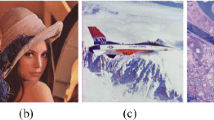Abstract
Watermarking inserts invisible data into content to protect copyright. The embedded information provides proof of authorship and facilitates the tracking of illegal distribution, etc. Current robust watermarking techniques have been proposed to preserve inserted copyright information from various attacks, such as content modification and watermark removal attacks. However, since the watermark is inserted in the form of noise, there is an inevitable effect of reducing content visual quality. In general, most robust watermarking techniques tend to have a greater effect on quality, and content creators and users are often reluctant to insert watermarks. Thus, there is a demand for a watermark that maintains maximum image quality, even if the watermark performance is slightly inferior. Therefore, we propose a watermarking technique that maximizes invisibility while maintaining sufficient robustness and data capacity to be applied in real situations. The proposed method minimizes watermarking energy by adopting curvelet domain multi-directional decomposition to maximize invisibility and maximizes robustness against signal processing attacks with a watermarking pattern suitable for curvelet transformation. The method is also robust against geometric attacks by employing the watermark detection method utilizing curvelet characteristics. The proposed method showed very good results of a 57.65 dB peak signal-to-noise ratio in fidelity tests, and the mean opinion score showed that images treated with the proposed method were hardly distinguishable from the originals. The proposed technique also showed good robustness against signal processing and geometric attacks compared with existing techniques.















Similar content being viewed by others
References
ASSEMBLY, ITU Radiocommunication (2003) Methodology for the subjective assessment of the quality of television pictures. International telecommunication Union, Geneva
Barni M, Bartolini F, Cappellini V, Piva A (1998) A DCT-domain system for robust image watermarking. Signal Process 66(3):357–372
Candès EJ, Donoho DL (2000) Curvelets: a surprisingly effective nonadaptive representation for objects with edges. Stanford Univ Ca Dept of Statistics, California
Candès EJ, Donoho DL (2004) New tight frames of curvelets and optimal representations of objects with piecewise C2 singularities. Commun Pure Appl Math 57(2):219–266
Candès EJ, Guo F (2002) New multiscale transforms, minimum total variation synthesis: applications to edge-preserving image reconstruction. Signal Process 82(11):1519–1543
Candès E, Demanet L, Donoho D, Ying L (2006) Fast discrete curvelet transforms. MMS 5(3):861–899
Channapragada RSR, Prasad MV (2015) Watermarking techniques in curvelet domain. In: Channapragada RSR, Prasad MVNK (eds) Computational intelligence in data mining-Volume 1 (pp 199–211). Springer, New Delhi
Chen B, Wornell GW (2001) Quantization index modulation: a class of provably good methods for digital watermarking and information embedding. IEEE Trans Inf Theory 47(4):1423–1443
Cox IJ, Kilian J, Leighton FT, Shamoon T (1997) Secure spread spectrum watermarking for multimedia. IEEE Trans Image Process 6(12):1673–1687
Cox I, Miller M, Bloom J, Fridrich J, Kalker T (2007) Digital watermarking and steganography. Morgan Kaufmann, Burlington
Fehn C (2004) Depth-image-based rendering (DIBR), compression, and transmission for a new approach on 3 D-TV. Proc SPIE 5291(2):93–104
Hirschmuller H, Scharstein D (2007) Evaluation of cost functions for stereo matching. IEEE 2007 conference on computer vision and pattern recognition, 1–8
Kim WH, Nam SH, Lee HK (2017) Blind curvelet watermarking method for high-quality images. Electron Lett 53(19):1302–1304
Makbol NM, Khoo BE, Rassem TH (2016) Block-based discrete wavelet transform-singular value decomposition image watermarking scheme using human visual system characteristics. IET Image Process 10(1):34–52
Nayak DR, Dash R, Majhi B, Prasad V (2017) Automated pathological brain detection system: a fast discrete curvelet transform and probabilistic neural network based approach. Expert Syst Appl 88:152–164
Nayak DR, Dash R, Majhi B (2018) Pathological brain detection using curvelet features and least squares SVM. Multimed Tools Appl 77(3):3833–3856
Nguyen SC, Ha KH, Nguyen HM (2015) An improved image watermarking scheme using selective curvelet scales. In Advanced Technologies for Communications (ATC), 2015 International conference on (pp 445–450). IEEE
Scharstein D, Pal C (2007) Learning conditional random fields for stereo. IEEE 2007 conference on computer vision and pattern recognition, 1–8
Scharstein D, Szeliski R (2003) High-accuracy stereo depth maps using structured light. IEEE 2003 computer society conference on computer vision and pattern recognition, 1, I-I
Scharstein D, Hirschmüller H, Kitajima Y, Krathwohl G, Nešić N, Wang X, Westling P (2014) High-resolution stereo datasets with subpixel-accurate ground truth. German conference on pattern recognition, 31–42
Sumana IJ, Islam MM, Zhang D, Lu G (2008) Content based image retrieval using curvelet transform. IEEE 10th workshop on multimedia signal processing, 11–16
Tao P, Dexterb S, Eskicioglub AM (2008) Robust digital image watermarking in curvelet domain. Methods 14:15
Wang Z, Bovik AC, Sheikh HR, Simoncelli EP (2004) Image quality assessment: from error visibility to structural similarity. IEEE Trans Image Process 13(4):600–612
Xie T, Kang L (2003) An evolutionary algorithm for magic squares. IEEE 2003 Congress on. Evol Comput 2:906–913
Zebbiche K, Khelifi F, Loukhaoukha K (2018) Robust additive watermarking in the DTCWT domain based on perceptual masking. Multimed Tools Appl 77:1–24
Zhang C, Cheng LL, Qiu Z, Cheng LM (2008) Multipurpose watermarking based on multiscale curvelet transform. TIFS 3(4):611–619
Zitnick CL, Kang SB, Uyttendaele M, Winder S, Szeliski R (2004) High-quality video view interpolation using a layered representation. ACM Trans Graph 23(3):600–608
Acknowledgements
This work was supported by the National Research Foundation of Korea (NRF) grant funded by the Korea government (MSIT)
Author information
Authors and Affiliations
Corresponding author
Additional information
Publisher’s Note
Springer Nature remains neutral with regard to jurisdictional claims in published maps and institutional affiliations.
Rights and permissions
About this article
Cite this article
Kim, WH., Nam, SH., Kang, JH. et al. Robust watermarking in curvelet domain for preserving cleanness of high-quality images. Multimed Tools Appl 78, 16887–16906 (2019). https://doi.org/10.1007/s11042-018-6879-3
Received:
Revised:
Accepted:
Published:
Issue Date:
DOI: https://doi.org/10.1007/s11042-018-6879-3




